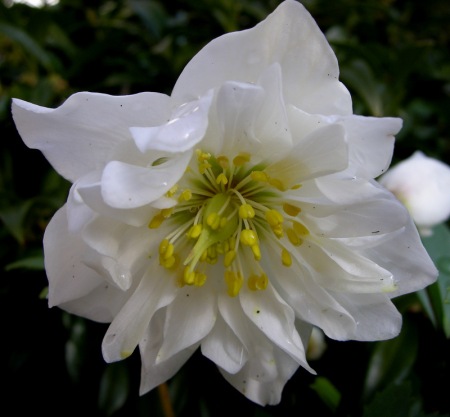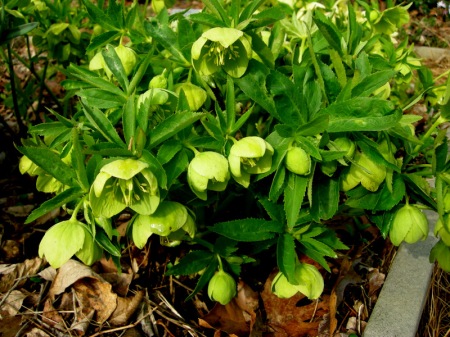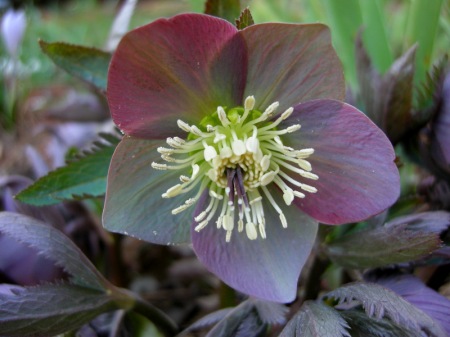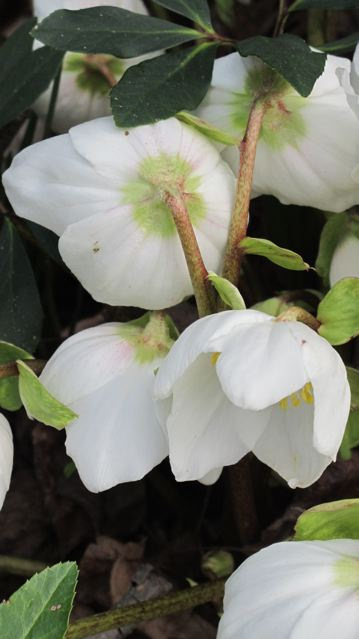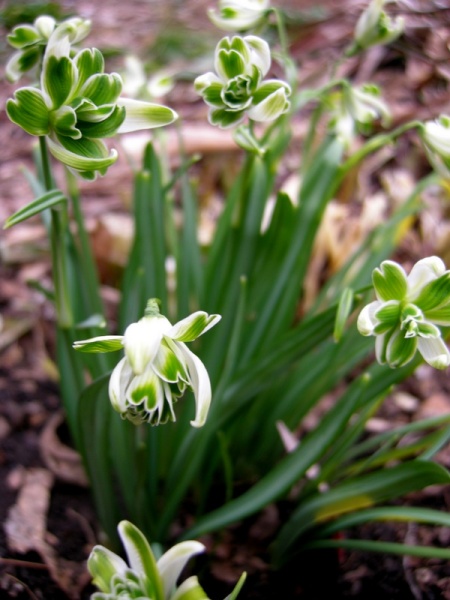Carolyn’s Shade Gardens is a retail nursery located in Bryn Mawr, PA, specializing in showy, colorful, and unusual plants for shade. The only plants that we ship are snowdrops and miniature hostas. For catalogues and announcements of events, please send your full name, location, and phone number (for back up use only) to carolyn@carolynsshadegardens.com. Click here to get to the home page of our website for catalogues and information about our nursery and to subscribe to our blog.
 ‘Emerald Blue’ moss phlox in my garden
‘Emerald Blue’ moss phlox in my garden
In my last post, Your Native Woodland, I explained how to create your own native woodland garden. Here I am going to profile some of the wonderful members of the genus Phlox, all native to eastern North America and Pennsylvania in particular.
All the plants except smooth and garden phlox are pictured blooming in my garden right now so I am linking to Garden Blogger’s Bloom Day (“GBBD”) hosted by May Dreams Gardens (link available on April 15) where gardeners from all over the world publish photos of what’s blooming in their gardens.
 ‘Sherwood Purple’ creeping phlox in my woodland
‘Sherwood Purple’ creeping phlox in my woodland
Phlox are very satisfying native plants to add to all areas of your garden. They are easy to grow and spread rapidly but not aggressively. All species that I am profiling are fragrant, some amazingly so, and attract butterflies and hummingbirds. They are also disease-free except garden phlox, which gets powdery mildew. And, most importantly, they have copious amounts of gorgeous flowers in purple, blue, pink, and white. Did I mention that they are native to Pennsylvania and all of eastern North America?!? What more could you want.
 Wild sweet William ‘Blue Moon’, Phlox divaricata
Wild sweet William ‘Blue Moon’, Phlox divaricata
Wild sweet William is the most fragrant of the phlox described here. Its heavenly scent perfumes the whole garden when it is in bloom from April to June. It is 8 to 10″ tall and spreading with semi-wintergreen leaves. Although I have seen it growing in the wild in full shade, I have better success with it in sun to part shade. Cut it back after flowering to maintain an attractive habit. My favorite cultivars are ‘Blue Moon’ (photo above), ‘May Breeze’ with steely white flowers, and ‘Blue Elf’, a compact form.
 ‘Morris Berd’ smooth phlox, Phlox glabberima
‘Morris Berd’ smooth phlox, Phlox glabberima
Smooth phlox is a taller clump-forming plant, although the clumps expand rapidly when it is happy. It is 18 to 24″ tall and grows in full sun to part shade in average to moist soil. Flowers appear from late spring to early summer, a time when not much else is blooming. The only smooth phlox I have ever seen for sale is ‘Morris Berd’ (photo above). Its velvety pink flowers with silver highlights are breathtaking.
 Garden phlox, P. paniculata, left with purple coneflower and ‘Goldsturm’ rudbeckia in my front border in 1993.
Garden phlox, P. paniculata, left with purple coneflower and ‘Goldsturm’ rudbeckia in my front border in 1993.
I dream of the day that I can plant a field of every cultivar of garden phlox on the market. The fragrance of the flowers, second only to wild sweet William, the long bloom period, and the colors available make this a very desirable plant. It grows anywhere in full sun to a good bit of shade (but not full shade). It reaches 2 to 4′, and I have cultivars blooming from June to October. My favorites are very early-blooming ‘Blue Paradise’ (photo below), compact ‘Pixie Miracle Grace’, pure white ‘David’, and ‘David’s Lavender’ with huge flower heads. Unfortunately, I have failed to photograph these plants in past years, but I hope to remedy that this summer.
I get questions all the time about powdery mildew on phlox. The only phlox that gets powdery mildew in my garden is garden phlox. The best way to avoid this is to buy mildew resistant varieties but in bad years even these cultivars get mildew. You can also prevent mildew organically by spraying the leaves with a baking soda and oil formula before mildew strikes. However, my approach is to ignore it because it doesn’t hurt the plants, it just looks ugly some years. Focus on the flowers instead and plant plants in front of the phlox that hide the leaves. Your garden does not have to look perfect.
 Creeping phlox ‘Blue Ridge’, P. stolonifera, in my woodland.
Creeping phlox ‘Blue Ridge’, P. stolonifera, in my woodland.
If I had to pick one phlox that is my favorite, it would be creeping phlox (not to be confused with P. subulata whose correct common name is moss phlox not creeping phlox). It has beautiful and plentiful fragrant flowers attractive to butterflies like all the native phlox here. But in addition, it grows in full, dry shade and makes an excellent 3 to 6″ mat-like groundcover that remains green through winter. It flowers from March to May. My favorite cultivars are ‘Sherwood Purple’ (photo at the beginning), which is the most vigorous, ‘Blue Ridge’ (photo above), ‘Home Fires’ (photo below), and ‘Pink Ridge’, which is a slightly different pink and blooms later than ‘Home Fires’.
.
 ‘Emerald Blue’ moss phlox, P. subulata, in my garden
‘Emerald Blue’ moss phlox, P. subulata, in my garden
For abundance of flowers, you can’t beat moss phlox: you can’t even see the leaves when it is in bloom in April and May. It grows in full sun to part shade and forms a wintergreen mat that solidly blocks out weeds. The needle-like leaves provide an attractive texture year round. A great plant for dry sites with thin soil because it has a shallow root system and likes to be well-drained. An annual shearing is recommended although I don’t do this.
A lot of breeding has been done with moss phlox to produce a plethora of beautiful flower colors. They are all good plants, and I don’t have a favorite, but I like ‘Emerald Blue’ (photo at beginning and above), pink ‘Fort Hill’, white with a red eye ‘Amazing Grace’ (photo above), and ‘Purple Beauty’ (photo below).
You can’t go wrong when you add any of these wonderful native phlox to your garden. Enjoy the flowers!
Carolyn
Nursery Happenings: My second Open House Sale, featuring spring-blooming plants for shade, will take place on Saturday, April 14, from 10 am to 3 pm. Look for an email listing the plants available if you are on my customer email list.
If you are within visiting distance and would like to receive catalogues and information about customer events, please send your full name and phone number to carolynsshadegardens@verizon.net. Subscribing to my blog does not sign you up to receive this information.
Facebook: Carolyn’s Shade Gardens has a Facebook page where I post single photos, garden tips, and other information that doesn’t fit into a blog post. You can look at my Facebook page here or click the Like button on my right sidebar here.
Notes: Every word that appears in orange on my blog is a link that you can click for more information. If you want to return to my blog’s homepage to access the sidebar information (catalogues, previous articles, etc.) or to subscribe to my blog, just click here.







